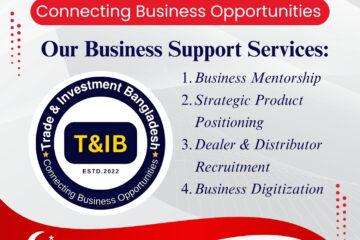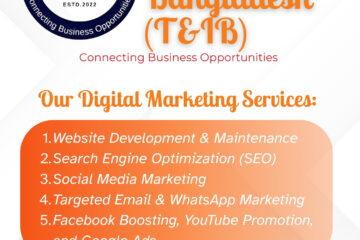Unlocking the Bangladeshi Market: Strategies for Successful Entry
Md. Joynal Abdin*
Business Consultant & Digital Marketer
Founder & CEO of Trade & Investment Bangladesh
Bangladesh, situated in South Asia, is a dynamic and rapidly growing economy with a population exceeding 160 million. Despite facing challenges such as poverty, political instability, and infrastructure constraints, Bangladesh has made significant strides in economic development over the past few decades.
The country’s economy has been experiencing robust growth, averaging around 6-7% annually over the past decade. This growth has been primarily driven by factors such as a burgeoning population, a young and increasingly educated workforce, and government initiatives aimed at fostering economic development.
Key Industries and Sectors Driving Growth:
- Textile and Garments: The textile and garments industry is the backbone of Bangladesh’s economy, accounting for a significant portion of the country’s exports. Bangladesh is one of the world’s largest producers and exporters of apparel, with a vast network of factories catering to international brands and retailers.
- Information Technology (IT) and Outsourcing: Bangladesh’s IT sector has been experiencing rapid growth, fueled by a growing pool of skilled IT professionals and favorable government policies. The country has emerged as an outsourcing destination for software development, IT services, and business process outsourcing (BPO).
- Agriculture: Agriculture remains a vital sector in Bangladesh, employing a large portion of the population and contributing significantly to the country’s GDP. Key agricultural products include rice, jute, tea, and fisheries.
- Pharmaceuticals: The pharmaceutical industry in Bangladesh has experienced significant growth, with a focus on generic drug manufacturing. The sector benefits from a large domestic market and export opportunities to neighboring countries.
- Renewable Energy: With a growing focus on sustainability and energy security, Bangladesh has been investing in renewable energy sources such as solar and wind power. Government incentives and foreign investment have been driving growth in this sector.
Opportunities and Challenges for Foreign Investors:
Opportunities:
- Large Consumer Market: Bangladesh offers a sizable and growing consumer market, driven by its large population and rising middle class.
- Cost-Competitive Labor: The country boasts a relatively low-cost labor force, making it an attractive destination for labor-intensive industries such as textiles and manufacturing.
- Government Incentives: The government of Bangladesh has been actively promoting foreign investment through incentives such as tax breaks, duty exemptions, and special economic zones.
- Strategic Location: Bangladesh’s strategic location in South Asia offers access to regional markets such as India, China, and Southeast Asia.
Challenges:
- Infrastructure Constraints: Bangladesh faces challenges related to inadequate infrastructure, including transportation, energy, and telecommunications, which can hinder business operations.
- Bureaucracy and Corruption: Foreign investors may encounter bureaucratic hurdles and corruption when navigating the regulatory environment in Bangladesh.
- Political Instability: The country has a history of political volatility, which can create uncertainty for investors and impact business operations.
- Social and Environmental Issues: Bangladesh grapples with social issues such as poverty, as well as environmental challenges such as climate change and natural disasters, which can affect business sustainability and continuity.
Understanding the Bangladeshi Consumer:
Bangladesh boasts a diverse demographic profile characterized by a large and youthful population. With over 160 million inhabitants, the country has a median age of around 27 years, indicating a predominantly young consumer base. Moreover, Bangladesh is experiencing urbanization, with a significant portion of the population residing in urban areas, where access to modern amenities and disposable income are on the rise.
Consumer behavior in Bangladesh is heavily influenced by factors such as cultural norms, socio-economic status, and technological advancements. While traditional values and customs still hold sway in many aspects of life, there is a growing trend towards modernization and adoption of Western lifestyles, particularly among urban youth.
Cultural Nuances and Preferences Influencing Purchasing Decisions:
Cultural nuances play a significant role in shaping consumer preferences and purchasing decisions in Bangladesh. Family and community values are highly regarded, influencing buying patterns and brand choices. Moreover, religious observances and festivals such as Eid-ul-Fitr and Durga Puja have a considerable impact on consumer spending, with increased demand for clothing, food, and gifts during these occasions.
Furthermore, trust and reputation are paramount in Bangladeshi culture, with consumers placing a premium on brands that are perceived as reliable and socially responsible. Brands that demonstrate an understanding of local customs and traditions and align with cultural values tend to resonate well with Bangladeshi consumers.
Market Research and Analysis Techniques to Identify Target Audience Segments:
To effectively penetrate the Bangladeshi market, businesses must conduct thorough market research and analysis to identify target audience segments and understand their needs, preferences, and behaviors. Several techniques can be employed for this purpose:
- Surveys and Focus Groups: Conducting surveys and focus groups allows businesses to gather qualitative insights into consumer preferences, attitudes, and buying habits. This approach helps in identifying specific demographic segments and understanding their motivations and decision-making processes.
- Data Analytics: Leveraging data analytics tools and techniques enables businesses to analyze consumer data, such as purchasing history, online behavior, and social media interactions. By mining and interpreting this data, businesses can identify patterns and trends, segment their target audience, and personalize marketing strategies accordingly.
- Ethnographic Research: Immersion in the local culture through ethnographic research provides valuable insights into consumer lifestyles, habits, and preferences. Observing consumer behavior in real-life settings helps businesses gain a deeper understanding of the cultural factors influencing purchasing decisions.
- Competitor Analysis: Analyzing competitors’ strategies and market positioning provides valuable insights into market dynamics and consumer preferences. By understanding competitors’ strengths and weaknesses, businesses can identify opportunities for differentiation and target underserved market segments.
- In-Depth Interviews: Conducting in-depth interviews with key stakeholders, such as industry experts, influencers, and opinion leaders, can provide valuable insights into market trends, consumer preferences, and emerging opportunities. These insights help businesses refine their market strategies and tailor their offerings to meet consumer needs effectively.
Legal and Regulatory Framework:
Bangladesh, located in South Asia, offers ample opportunities for businesses with its growing economy and strategic geographical location. However, navigating the legal landscape is crucial for success. Here’s an overview of business laws and regulations in Bangladesh:
- Company Registration: The primary law governing company registration in Bangladesh is the Companies Act, 1994. The Registrar of Joint Stock Companies and Firms (RJSC) is responsible for company registration. The process involves submitting necessary documents, including the company’s memorandum and articles of association, to the RJSC. Once approved, the company receives a certificate of incorporation.
- Licensing and Permits: Depending on the nature of the business, additional licenses and permits may be required. For example, businesses operating in sectors such as banking, insurance, telecommunications, pharmaceuticals, and energy require specific licenses from relevant regulatory authorities. It’s essential to identify and obtain the necessary licenses and permits before commencing operations.
- Compliance Requirements: Businesses operating in Bangladesh must adhere to various compliance requirements, including tax regulations, labor laws, environmental regulations, and corporate governance standards. The National Board of Revenue (NBR) oversees tax compliance, while the Department of Environment monitors environmental regulations. Additionally, businesses must comply with labor laws concerning employment contracts, working conditions, and employee rights.
- Legal Pitfalls for Foreign Businesses: Foreign businesses entering the Bangladeshi market should be aware of potential legal pitfalls. These may include challenges related to contract enforcement, intellectual property protection, corruption, and political instability. It’s crucial for foreign businesses to conduct thorough due diligence, seek legal advice, and establish strong relationships with local partners to navigate these challenges effectively.
- Intellectual Property Rights (IPR) Protection: Protecting intellectual property rights is crucial for businesses operating in Bangladesh. The country has laws governing patents, trademarks, copyrights, and industrial designs. However, enforcement of IPR laws can be challenging, and instances of infringement are not uncommon. Foreign businesses should register their intellectual property in Bangladesh and implement robust measures to safeguard their rights.
- Dispute Resolution: In case of disputes, businesses in Bangladesh can seek resolution through litigation, arbitration, or alternative dispute resolution mechanisms. The court system in Bangladesh handles civil and commercial disputes, although legal proceedings can be time-consuming. Arbitration, both domestic and international, is also a common method for resolving commercial disputes and offers a more efficient and neutral alternative to litigation.
Market Entry Strategies:
- Joint Ventures: Partnering with a local company through a joint venture can provide access to local knowledge, resources, and networks while sharing risks and costs. This mode can be beneficial for navigating regulatory complexities and cultural nuances in Bangladesh.
- Wholly-Owned Subsidiaries: Establishing a wholly-owned subsidiary gives complete control over operations and decision-making. This mode is suitable for businesses with significant capital and expertise to penetrate the Bangladeshi market independently.
- Partnerships: Collaborating with local distributors, agents, or suppliers through partnerships can help leverage existing networks and infrastructure in Bangladesh. This mode allows for flexibility and can be suitable for businesses looking to test the market before making significant investments.
Assessing Market Entry Barriers and Entry Timing:
- Regulatory Barriers: Evaluate regulatory requirements, licensing procedures, and compliance challenges in Bangladesh. Understanding the legal framework is crucial for selecting the appropriate entry mode and timing.
- Cultural and Social Factors: Consider cultural norms, consumer preferences, and social dynamics in Bangladesh. Adapting products, services, and marketing strategies to align with local preferences can enhance market acceptance.
- Economic Factors: Assess economic conditions, market trends, and competition in Bangladesh. Analyze factors such as purchasing power, inflation rates, and currency fluctuations to determine the right timing for market entry.
- Infrastructure and Logistics: Evaluate infrastructure facilities, transportation networks, and logistics capabilities in Bangladesh. Accessibility to distribution channels and supply chain efficiency can impact market entry decisions.
Developing a Market Entry Strategy tailored to Bangladesh:
- Market Research: Conduct thorough market research to understand consumer behavior, competitive landscape, and industry dynamics in Bangladesh. Identify market gaps, opportunities, and potential challenges to inform strategy development.
- Localization: Customize products, services, and marketing strategies to meet the unique needs and preferences of Bangladeshi consumers. Localization efforts can enhance brand relevance and competitiveness in the market.
- Strategic Partnerships: Form strategic partnerships with local companies, distributors, or suppliers to leverage their expertise, networks, and resources. Collaborating with established players can accelerate market penetration and mitigate risks.
- Comprehensive Marketing Plan: Develop a comprehensive marketing plan encompassing branding, advertising, promotions, and distribution strategies tailored to the Bangladeshi market. Utilize both traditional and digital channels to reach target audiences effectively.
- Continuous Evaluation and Adaptation: Continuously monitor market dynamics, consumer feedback, and competitive developments in Bangladesh. Stay agile and be prepared to adapt market entry strategies based on evolving market conditions and feedback.
Localization and Adaptation:
In today’s globalized marketplace, localization plays a pivotal role in the success of businesses expanding into new markets. Here’s why localizing products, services, and marketing strategies is crucial:
- Meeting Customer Preferences: Localizing products and services allows businesses to cater to the unique preferences and needs of consumers in different markets. By understanding local tastes, preferences, and cultural nuances, businesses can develop offerings that resonate with target audiences, leading to higher customer satisfaction and loyalty.
- Enhancing Brand Relevance: Adapting marketing strategies to local customs, language, and cultural norms helps businesses establish a deeper connection with consumers. It demonstrates a commitment to understanding and respecting local culture, which can enhance brand perception and relevance in the market.
- Improving Communication Effectiveness: Language is a powerful tool for communication. By speaking the local language and using culturally relevant messaging, businesses can effectively communicate their value proposition, build trust with consumers, and drive engagement.
- Gaining Competitive Advantage: Localization allows businesses to differentiate themselves from competitors by offering tailored solutions that address the specific needs of local customers. It can also help businesses identify and capitalize on market gaps or opportunities that may be overlooked by competitors.
- Mitigating Risks: Failure to localize products, services, and marketing strategies can lead to misinterpretations, misunderstandings, or even cultural faux pas that can damage brand reputation and hinder market penetration. Localization helps mitigate these risks by ensuring that businesses adapt to local norms and customs appropriately.
Adapting to Local Customs, Language, and Cultural Norms:
Successful market entry strategies often involve adapting to local customs, language, and cultural norms. Here’s how businesses can effectively navigate these aspects:
- Language Localization: Translate product labels, packaging, websites, and marketing materials into the local language to ensure clear communication with customers. Hiring native speakers or working with professional translators can help maintain linguistic accuracy and cultural sensitivity.
- Cultural Sensitivity: Conduct cultural research to understand local customs, traditions, and taboos. Avoid cultural stereotypes and ensure that marketing messages resonate positively with the target audience. Tailor product features, designs, and packaging to align with cultural preferences and aesthetics.
- Customized Marketing Strategies: Develop marketing campaigns that reflect local values, beliefs, and aspirations. Use imagery, symbols, and references that are culturally relevant and resonate with the target audience. Leverage local media channels, influencers, and events to amplify brand visibility and engagement.
- Personalized Customer Experience: Adapt customer service practices to accommodate cultural norms and expectations. Train staff to understand and respect cultural differences in communication styles, gestures, and etiquette. Offer localized support channels and resources to address customer inquiries and concerns effectively.
Case Studies of Successful Market Entry Strategies with a Focus on Localization:
- McDonald’s in India: McDonald’s successfully localized its menu offerings in India to cater to the preferences of vegetarian consumers. The introduction of vegetarian options such as the McAloo Tikki burger and the Maharaja Mac, along with localized marketing campaigns featuring Bollywood celebrities, helped McDonald’s establish a strong presence in the Indian market.
- IKEA in China: IKEA adapted its product assortment and store layouts to align with Chinese consumer preferences and lifestyle habits. By offering smaller furniture sizes, integrating traditional Chinese elements into product designs, and providing in-store amenities such as childcare facilities and restaurants serving local cuisine, IKEA effectively localized its offerings for the Chinese market.
- Coca-Cola in Mexico: Coca-Cola leveraged its “Share a Coke” campaign in Mexico by personalizing bottles with popular Mexican names and phrases. This localized marketing initiative resonated with Mexican consumers, driving increased sales and brand engagement. Additionally, Coca-Cola partnered with local artists and influencers to create culturally relevant content that further enhanced its connection with the Mexican audience.
Building Strategic Partnerships:
Identifying and Establishing Relationships with Local Partners, Distributors, and Suppliers:
- Market Research: Conduct thorough market research to identify potential local partners, distributors, and suppliers with a strong understanding of the target market and industry dynamics. Utilize industry associations, trade shows, online directories, and referrals from business networks to identify suitable candidates.
- Networking: Attend networking events, industry conferences, and business forums to connect with local stakeholders and build relationships. Engage in informal conversations, exchange business cards, and seek opportunities for collaboration. Building rapport and establishing trust are essential steps in developing fruitful partnerships.
- Referrals and Recommendations: Seek referrals and recommendations from trusted sources, such as industry experts, consultants, or other businesses operating in the local market. Recommendations from reliable sources can help identify reputable partners and suppliers with a track record of success.
- Due Diligence: Conduct due diligence on potential partners, distributors, and suppliers to assess their reputation, reliability, financial stability, and compatibility with your business goals and values. Verify credentials, review past performance, and seek references to ensure credibility and mitigate risks.
- Initial Meetings and Discussions: Arrange initial meetings with prospective partners, distributors, and suppliers to discuss mutual interests, objectives, and expectations. Clarify roles, responsibilities, and key deliverables to establish a shared understanding of the partnership goals and framework.
- Negotiation: Engage in constructive negotiations to finalize terms and conditions that are fair and beneficial for both parties. Be prepared to compromise and find creative solutions to address any differences or concerns. Clearly define contractual agreements, including pricing, payment terms, exclusivity clauses, and termination provisions.
Leveraging Partnerships for Market Insights, Distribution Networks, and Market Penetration:
- Market Insights: Collaborate with local partners to gain valuable market insights, including consumer preferences, competitive landscape, regulatory requirements, and emerging trends. Leverage their knowledge and expertise to adapt strategies and offerings to better meet market demands and capitalize on opportunities.
- Distribution Networks: Partner with local distributors to leverage their established distribution networks, infrastructure, and logistics capabilities. Tap into their existing relationships with retailers, wholesalers, and other distribution channels to expand market reach and increase product availability.
- Market Penetration: Work closely with partners to develop targeted marketing and sales strategies aimed at penetrating the market effectively. Utilize their local networks and resources to promote products, generate leads, and secure sales opportunities. Collaborate on promotional campaigns, events, and activations to increase brand visibility and customer engagement.
- Customer Relationships: Build strong relationships with customers through effective communication, responsive service, and personalized experiences. Leverage partner networks to gather feedback, address customer needs, and enhance satisfaction levels. Use customer insights to refine product offerings, improve service quality, and strengthen brand loyalty.
Negotiation Tactics and Strategies for Building Mutually Beneficial Partnerships:
- Preparation: Conduct thorough preparation by researching the partner’s background, market position, and negotiation style. Define your objectives, priorities, and fallback positions to guide the negotiation process effectively.
- Establish Rapport: Build rapport and establish a positive relationship with the partner through open communication, active listening, and mutual respect. Find common ground and demonstrate empathy to create a conducive environment for negotiation.
- Focus on Win-Win Outcomes: Adopt a collaborative approach focused on creating mutually beneficial outcomes for both parties. Seek to identify shared interests, goals, and areas of value creation that can be leveraged to build a sustainable partnership.
- Flexibility and Creativity: Remain flexible and open-minded throughout the negotiation process, willing to explore alternative solutions and compromise where necessary. Be creative in proposing innovative ideas and solutions that address the partner’s needs while advancing your own interests.
- Clear Communication: Clearly communicate your expectations, requirements, and concerns during the negotiation process. Listen actively to the partner’s perspective, ask clarifying questions, and seek clarification to ensure mutual understanding and alignment.
- Negotiation Techniques: Employ negotiation techniques such as active listening, questioning, framing, and bundling to influence the discussion and achieve favorable outcomes. Use persuasive language, storytelling, and evidence-based arguments to support your proposals and overcome objections.
- Finalize Agreements: Once consensus is reached on key terms and conditions, document the agreement in a legally binding contract outlining rights, obligations, and dispute resolution mechanisms. Ensure that the contract reflects the negotiated terms accurately and comprehensively to minimize misunderstandings and mitigate risks.
To read 2nd part of this article, click here!
Unlocking the Bangladeshi Market: Strategies for Successful Entry :: Unlocking the Bangladeshi Market: Strategies for Successful Entry
 Md. Joynal Abdin, Business Consultant & Digital Marketer Mr. Md. Joynal Abdin is a prominent Business Consultant and Digital Marketer based in Dhaka, Bangladesh. He holds the role of Founder and CEO at Trade & Investment Bangladesh. With an extensive professional journey, he has contributed significantly, having served as Executive Secretary at Dhaka Chamber of Commerce & Industry (DCCI), Executive Director at DCCI Business Institute (DBI), Deputy Manager at SME Foundation, and Assistant Secretary at the Federation of Bangladesh Chambers of Commerce & Industry (FBCCI).
Md. Joynal Abdin, Business Consultant & Digital Marketer Mr. Md. Joynal Abdin is a prominent Business Consultant and Digital Marketer based in Dhaka, Bangladesh. He holds the role of Founder and CEO at Trade & Investment Bangladesh. With an extensive professional journey, he has contributed significantly, having served as Executive Secretary at Dhaka Chamber of Commerce & Industry (DCCI), Executive Director at DCCI Business Institute (DBI), Deputy Manager at SME Foundation, and Assistant Secretary at the Federation of Bangladesh Chambers of Commerce & Industry (FBCCI).
Mr. Abdin’s diverse array of services encompasses, but is not confined to, Business Mentorship, Business Research and Documentation, such as Feasibility Studies, Project Proposal Preparation, and Business Manual and Standard Operating Procedures writing. He is also adept at Export Market Selection, Product Positioning both domestically and internationally, Buyers-Sellers Matchmaking, Website Development, Search Engine Optimization (SEO), and Social Media Marketing, Email Marketing etc. among other valuable offerings.





0 Comments